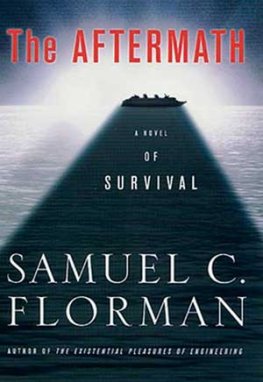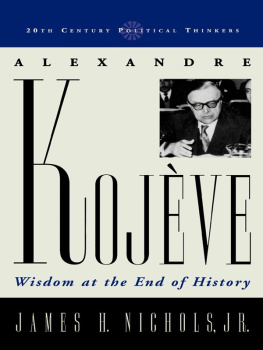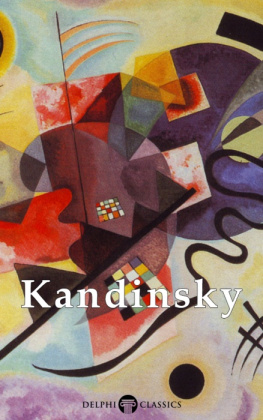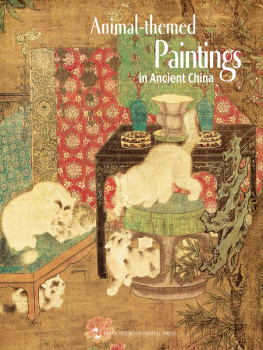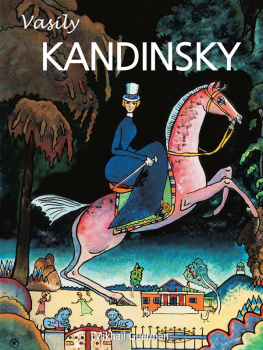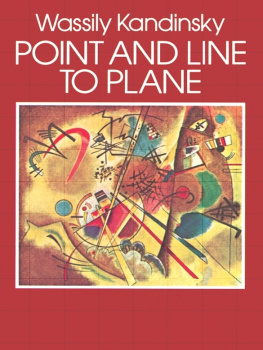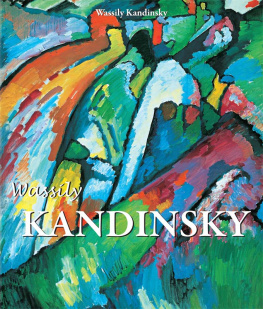CONCERNING THE SPIRITUAL AND THE CONCRETE IN KANDINSKYS ART
LISA FLORMAN
STANFORD UNIVERSITY PRESS
STANFORD CALIFORNIA
Stanford University Press
Stanford, California
2014 by the Board of Trustees of the Leland Stanford Junior University. All rights reserved.
No part of this book may be reproduced or transmitted in any form or by any means, electronic or mechanical, including photocopying and recording, or in any information storage or retrieval system without the prior written permission of Stanford University Press.
Printed in the United States of America on acid-free, archival-quality paper
Library of Congress Cataloging-in-Publication Data
Florman, Lisa Carol, author.
Concerning the spiritual and the concrete in Kandinskys art / Lisa Florman.
pages cm
Contains an English translation of Les Peintures concrtes de Kandinsky by Alexandre Kojve.
Includes bibliographical references and index.
ISBN 978-0-8047-8483-2 (cloth : alk. paper) ISBN 978-0-8047-8484-9 (pbk. : alk. paper)
1. Kandinsky, Wassily, 1866-1944Criticism and interpretation. 2. Hegel, Georg WilhelmFriedrich, 1770-1831. sthetik. 3. Painting, Abstract. 4. Painting, Modern20th century. 5. ArtPhilosophy. 6. Aesthetics. I. Kojve, Alexandre, 1902-1968. Peintures concrtes de Kandinsky. English. II. Title.
ND699.K3F59 2014
759.7dc23
2013021476
ISBN 978-0-8047-8923-3 (electronic)
Designed by Bruce Lundquist
Typeset at Stanford University Press in 10/15 Adobe Garamond Pro
For Ellie
CONTENTS
ILLUSTRATIONS
PLATES
The Plates appear in a separate full-color section.
FIGURES
.
.
.
.
.
.
.
.
.
.
.
.
.
.
.
.
.
.
.
.
.
.
.
.
.
.
.
.
.
.
.
.
.
.
.
.
.
.
.
.
.
.
ACKNOWLEDGMENTS
A book this long in the making incurs many debts on the way to completion. To begin with those of the longest standing: An early version of some of this material was presented in 2004 at the annual meeting of the College Art Association, in a session on Modernist Abstraction across the Disciplines. Id like to thank the two session chairs, Marek Wieczorek and Marshall Brown, for the invitation to participate and for their feedback at that time.
The project began to take shape in earnest during the autumn of 2006, when I was fortunate enough to have held the Agnes Gund and Daniel Shapiro Membership at the Institute for Advanced Study in Princeton. My deepest appreciation goes not only to Agnes Gund and Daniel Shapiro, whose support made my stay there possible, but also to everyone at the School of Historical Studies who commented on the work in progress, especially Yve-Alain Bois, Bettina Gockel, Cordula Grewe, Christopher Hailey, and Avishai Margalit. A return visit to the IAS during the 20092010 academic yearthis time as a trailing spouseadvanced the manuscript even further. The conversations I had then (and have continued to have since), on matters both related to the book and not, with Yve-Alain Bois, Susan Laxton, Eric Michaud, and Maria Stavrinaki, have sustained me throughout the process. The opportunity to discuss my work with members of the Princeton University faculty was equally valuable. Im deeply grateful to Brigid Doherty, Hal Foster, Michael Koortbojian, Esther da Costa Meyer, Spyros Papapetros, and Molly Warnock (then at Princeton) for their interest in the project. Brigid in particular helped me to see several important aspects of my argument whose full weight I had not quite caught, and Hal pointed me to the essay on Hegel and Kandinsky by Jean-Joseph Goux that importantly shaped my conclusion.
A number of colleagues at Ohio State University, both past and present, also contributed enormously to this book, often in ways difficult to measure. No doubt my deepest debt is to Stephen Melville, whose frequent talks with me about Hegel (and all manner of other things) I miss more than I can say. For their general encouragement, and friendship, I also want to thank Judy Andrews, Philip Armstrong, Amanda Boetzkes, Gwyn Dalton, Mark Fullerton, Amanda Gluibizzi, Ron Green, Barbara Groseclose, Barbara Haeger, Byron Hamann, Mary Jones, Youn-mi Kim, Christian Kleinbub, Namiko Kunimoto, Laura Lisbon, Tim McNiven, Myroslava Mudrak, Kris Paulsen, Andrew Shelton, Aron Vinegar, and Karl Whittington, as well as all of the other faculty and students, both within the History of Art Department and across the university, with whom Ive spent the better part of two decades. An invitation from Graeme Boone to present the portion of the text concerning Kandinsky and Schoenberg to the OSU musicologists helped to reassure me, at a crucial moment, that I was not wholly out of my depth.
Scholars who read all or part of the manuscript and generously offered their thoughts include Warren Breckmann, Jason Gaiger, and Bibiana Obler. To Jason in particularwho, heroically, read and provided commentary on the work in its entiretyI am grateful. (Whatever mistakes remain I have to acknowledge, stubbornly, as my own.) Thanks are due as well to Todd Cronan for organizing the Modernism seminar at Emory University where I was able to present the chapter on Kojves Les Peintures concrtes. To Todd, Nell Andrew, Liz Goodstein, Sarah Hamill, Gordon Hughes, Dalia Judowitz, Andrew Mitchell, Charles Palermo, and Michael Schreyach: thank you for your careful reading and perceptive questions.
For their help with obtaining the many images required for this book, Im indebted to Stephanie Bernhardt, Kristin Brockman, Mary-Allen Johnson, Michelle Maguire, Predrag Matejic, Romain Paumard, MaryBeth Robinson, and Catherine Walworth. Tracey Bashkoff and Gillian McMillan gave generously of their time, providing me access to many of the works by Kandinsky in the Guggenheim Collection that were not on display when I needed to see them. The opportunity to examine Painting with White Border in the conservation lab, and to ask questions of those who knew the work so well, remains for me one of the highlights of the entire project.
Alexandre Kojves essay on Kandinsky has been central to my conception of this book from the beginning. Permission to publish a translation of Les Pein-tures concrtes de Kandinsky was kindly granted by Madame Nina Kousnetzoff. I am enormously grateful to her, and to Michael S. Roth for his communications with me about that text. The entire staff of the Bibliothque Kandinsky in Paris, where the manuscript is housedfrom Didier Schulmann, the director, to Vronique Borgeaud and Brigitte Vincenscould not have been more helpful.
To my editor, Emily-Jane Cohen, at Stanford University Press: thank you for your patience and for your commitment to the project. I know its been a much longer haul than you originally anticipated.
Valuable funding for some of the research and images for the book came from the Ohio State University College of the Arts and Sciences, and the Virginia Hull Research Award, as well as from the OSU History of Art Department. The support of all three was and is much appreciated.
Over the decade or so that Ive been working on this project, numerous family members and friends (in addition to those already mentioned) served as interlocutors or, just as importantly, offered their moral support. Among them Id like to mention Michele Acker, Trisha Craig, Susan Dackerman, Susan Glaser, Ann Hamilton, Josiah McElheny, Ruth Melville, Michael Mercil, Ara Merjian, Helen Molesworth, Tom Nelson, Frank and Kathy Richardson, Hans-Walter Rix, Sarah Rogers, Birgitte Sland, Bob and Wendy Weinberg, and pretty much the entire staff of the Northstar Caf in the Short North.
Next page

